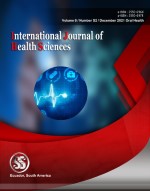An overview of class II division 2 malocclusion
Keywords:
retention, skeletal malocclusion, retroclination, etiologyAbstract
Class II malocclusion is the condition in which the mandibular first molars occlude distal to the normal relationship with the maxillary first molar. The etiology of class II malocclusion varied between skeletal, soft tissues, dental factors and habits. Skeletal class II could be because of protrusion of maxilla, retrusion of mandible and combination of both. The treatment modalities of any skeletal problem include growth modification, dental camouflage and orthognathic surgery. This article elaborates the etiology, clinical features, treatment objectives, orthodontic corrections, retention for class II division 2 maloclussion.
Downloads
References
Angle eh. Treatment of malocclusion of the teeth and Fractures of the maxillae. In: angle’s system, ed 6. Philadelphia: ss white dental mfg co ;1900.
Van der linden fpgm . Development of the dentition. Chicago: Quintessence Publishing Co., Inc., pp. 93–103 (1983).
Franchi, l. Alvetro, v. Giuntini, c. Masucci, e. Defraia, and t. Baccetti, “effectiveness of comprehensive fixed appliance treatment used with the forsus fatigue resistant device in class II patients,” the angle orthodontist, vol. 81, no. 4, pp. 678–683, 2011.
V. F. Zymperdikas, v. Koretsi, s. N. Papageorgiou, and m. A. Papadopoulos, “treatment effects of fixed functional appliances in patients with class II malocclusion: a systematic review and meta-analysis,” the european journal of orthodontics, 2015.
Dalci, a. T. Altuğ, and u. T. Memikoglu, “treatment effects of a twin-force bite corrector versus an activator in comparison with an untreated class II sample: a preliminary report,” australian orthodontic journal, vol. 30, no. 1, pp. 45–53, 2014.
Pancherz H, Zieber K, Hoyer B. Cephalometric characteristics of class II division 1 and class II Division 2 malocclusions: a comparative study in children. Angle orthod 1997;67:111–120.
Fletcher GG. The retroclined upper incisor. Br j Orthod 1975;2:207–216.
Lapatki BG, mager AS, schulte-moenting J, jonas ie. The importance of the level of the lip line and resting Lip pressure in class II, division 2 malocclusion. J dent res 2002;81:323–328.
Heide m. Class II, division 2—a challenge. Angle Orthod 1957;27:159.
Uribe F, nanda. Treatment of class II, division 2 Malocclusion in adults: biomechanical considerations. J clin orthod 2003;37:599–606.
Stoelinga PJ, leenen RJ. Class II anomalies: a coordinated approach to the management of skeletal, Dental, and soft tissue problems. J oral surg 1981;39:827–841.
Arvystas mg. Treatment of severe mandibular retrusion in class II, division 2 malocclusion. Am j Orthod 1979;76:149–164. Lee kf, tseng yc, chang hp, chou st
Litt ra, nielsen il. Class II, division 2 malocclusion. to extract—or not extract? Angle orthod
1984;54:123–138.
Tsou CH, kuo CL, liuYH, wang YY extraction or non-extraction treatment of class II division 2 malocclusion adult patients–case report. J Taiwan Assoc orthod 2014;26:114–127.
Pullinger AG, solberg WK, Hollender l, Petersson A, relationship of mandibular condylar position to dental occlusion factors in an asymptomatic population. Am J orthod dentofacial orthop. 1987 mar;91(3):200-6.
Anders CL, harzer W, eckardt L. Axiographic evaluation of mandibular mobility in children with Angle class-II/2 malocclusion (deep overbite). J orofac orthop. 2000;61(1):45-53.
Stamm TL, vehring A, ehmer U, bollmann F, computer-aided axiography of asymptomatic
Individuals with class II. J orofac orthop. 1998;59(4):237-45.
18. Millett DT, cunningham SJ, o’brien kd, benson pe, De oliveira cm. Treatment and stability of class II Division 2 malocclusion in children and adolescents: A systematic review. Am j orthod dentofacial orthop 2012;142:159–169.
19. Orthodontic Correction of Class II Division 2 Malocclusion. Kun-Feng Lee Department of Orthodontics, Dental Clinics, Kaohsiung Medical University Hospital, Kaohsiung Taiwan (2018).
Published
How to Cite
Issue
Section
Copyright (c) 2022 International journal of health sciences

This work is licensed under a Creative Commons Attribution-NonCommercial-NoDerivatives 4.0 International License.
Articles published in the International Journal of Health Sciences (IJHS) are available under Creative Commons Attribution Non-Commercial No Derivatives Licence (CC BY-NC-ND 4.0). Authors retain copyright in their work and grant IJHS right of first publication under CC BY-NC-ND 4.0. Users have the right to read, download, copy, distribute, print, search, or link to the full texts of articles in this journal, and to use them for any other lawful purpose.
Articles published in IJHS can be copied, communicated and shared in their published form for non-commercial purposes provided full attribution is given to the author and the journal. Authors are able to enter into separate, additional contractual arrangements for the non-exclusive distribution of the journal's published version of the work (e.g., post it to an institutional repository or publish it in a book), with an acknowledgment of its initial publication in this journal.
This copyright notice applies to articles published in IJHS volumes 4 onwards. Please read about the copyright notices for previous volumes under Journal History.
















